#tang dynasty hanfu timeline
Explore tagged Tumblr posts
Photo
Tang dynasty aesthetic
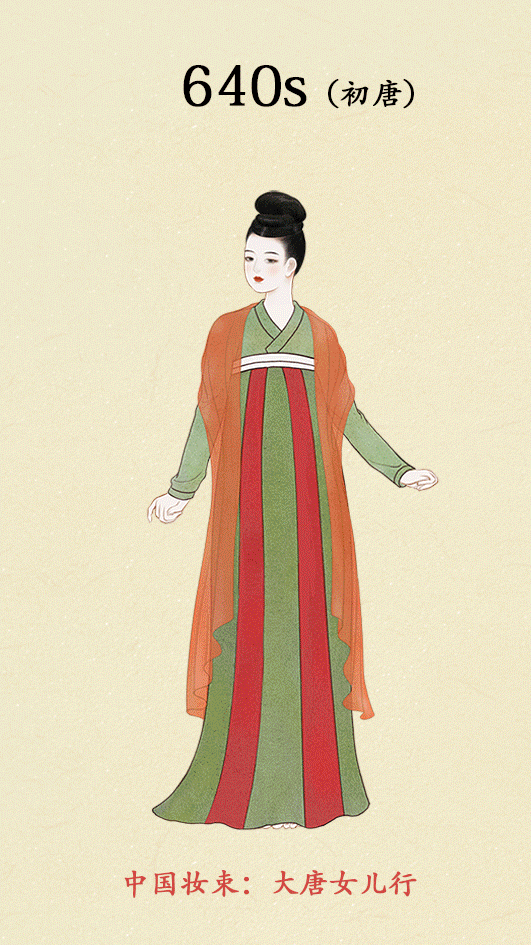
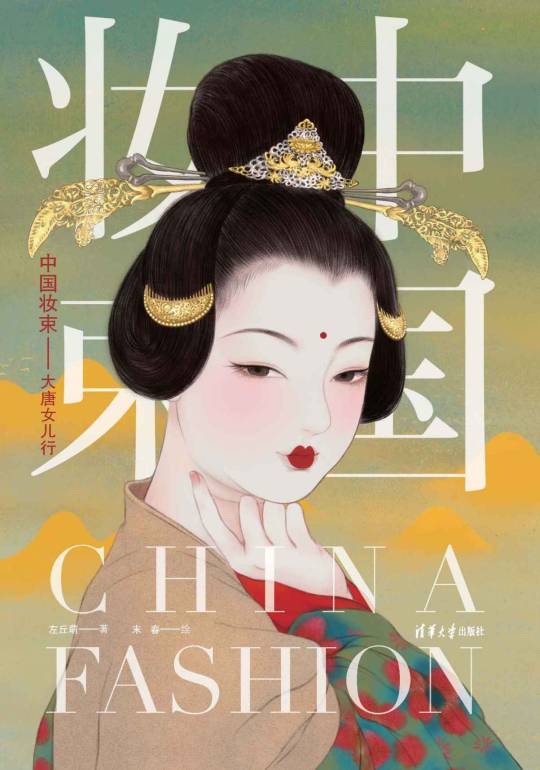
[Hanfu · 漢服]Chinese Traditional Clothing Hanfu in different periods of the Tang Dynasty BY Artist: @末春 & 左丘萌 in Book《 中国妆束-大唐女儿行 /China Fashion》
————–
“中国妆束-大唐女儿行” attempts to re-interpret the real fashion of women’s make-up at that time with the view of the Tang Dynasty people based on the Tang Dynasty cultural relics found in archaeological excavations and compared with the records in handed down historical materials or unearthed documents.
————–
Publisher : 清华大学出版社; 第1版 (July 1, 2020)
Publication date : July 1, 2020
Language : Chinese
Amazon: 中国妆束:大唐女儿行 (Chinese Edition) Kindle Edition
#tang dynasty#hanfu#tang dynasty hanfu#tang dynasty clothing#tang dynasty clothes#china#chinese clothing#chinese clothes#tang dynasty aesthetic#chinese culture#chinese history#aesthetic#mood#asia#asian clothing#chinese hanfu#hanfu history#hanfu accessories#chinese costume#china fashion#chinese art#historical clothing#historical fashion#historical hairstyles#chinese dress#chinese traditional clothing#hanfu timeline#tang dynasty hanfu timeline#tang dynasty makeup & hairstyles timeline#historical costumes
238 notes
·
View notes
Text

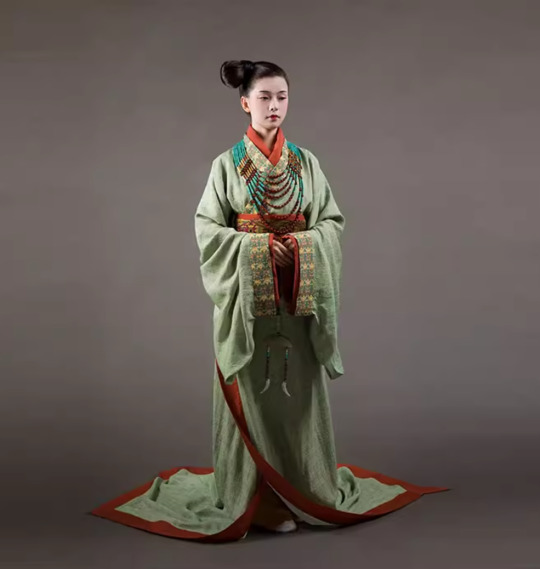
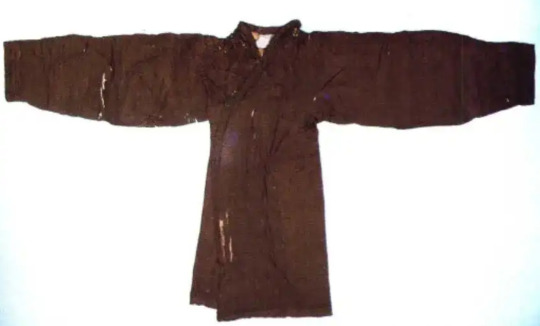

直裾战国袍 / Straight-edged Warring States robe: Distinguished by the excessive amount of fabric for the sleeves and the waist-to-floor straight edge, this style of Warring States robe was worn between the Warring States period and the Han Dynasty.
Warring States robes can usually be purchased in 2 lengths; - trailing on the floor (great for photos, awful for walking) - hemmed right at the floor (not as beautiful in photos, a lot easier for walking) Most stores selling this style of robes have skipped the extra piece of fabric between the sleeve and body, changing the entire drape of the fabric. Instead of it naturally opening at the front, this small change in the design causes the fabric to be completely closed at the front which makes walking without stepping on the fabric impossible (speaking from personal experience) T___T
==**==**==**==**==**==**==**==
Hanfu, the historical clothing of the Han people in China, has thousands of years of history. Since the 2000s, there has been a revival of Hanfu within China, with many Hanfu stores opening in the past two decades.
I first became aware that I could purchase Hanfu in 2021 and hoarded a bunch. Recently, I started digging more and more into the topic and realized that, while many of the Hanfu being sold are beautiful, they're not exactly true to the styles of Hanfu in the past. That's not to say they shouldn't be sold or worn, I'm not interested in gatekeeping what others wear, but I became intrigued by what exactly DID the historical Hanfu styles look like based on historical artefacts.
For my own interest, and for any others who might be interested, I'm going to try and do a series of the various Hanfu styles throughout the dynasties.
Chinese dynasties timeline for reference:
Shang Dynasty 商 (1300–1046 BC) Zhou Dynasty 周 (1046–256 BC) Western Zhou 西周 (1046–771 BC) Eastern Zhou 东周 >> Spring and Autumn Period 春秋 (770–481 BC) >> Warring States Period 战国 (481–221 BC) Qin Dynasty 秦 (221–207 BC) Han Dynasty 汉 >> Western Han 西汉 (206 BC–8 AD) >> Xin Dynasty 新 (9–23) >> Eastern Han 东汉 (25–220) Three Kingdoms 三国 (220–265) Jin Dynasty 晋 >> Western Jin 西晋 (265–316) >> Eastern Jin 东晋 (317–420) Northern and Southern Dynasties 南北朝 (420–589) Sui Dynasty 隋 (581–618) Tang Dynasty 唐 (618–907) Five Dynasties 五代 (907–960) Song Dynasty 宋 >> Northern Song 北宋 (960–1127) >> Southern Song 南宋 (1127–1279) Yuan Dynasty (Mongols) 元 (1271–1368) Ming Dynasty 明 (1368–1644) Qing Dynasty (Manchus) 清 (1644–1911) Republic of China 民国 (1912–1949) People's Republic of China 中华人民共和国 (1949-present)
326 notes
·
View notes
Note
do you know roughly what time period mount hua takes place? like if its during a specific dynasty or anything
most murim/wuxia take place in a very vague ancient time period that, unless the author specifically mentions what year it is, its impossible to tell.. as for rotmhs i dont think a specific year/dynasty has ever been mentioned so u pretty much have free range to put rotmhs in whichever dynasty feels right to you
ive seen some people speculate on time periods based on the type of hanfu characters wear but that hardly ever holds up seeing how in most wuxia media (mostly xianxia but i digress) that take place in this vague-wuxia-timeline, the robes are often mashed together into a conglomerate of a bunch of different dynastys styles, that or theyre purely fictional and only exist to be aesthetically pleasing and more xianxia-like..
purely my own headcanon though i like to imagine current timeline rotmhs takes place mid to late tang dynasty, chung myung having lived his life as geomjon some point in the early years of the sui dynasty and into the tang dynasty..or something.. *scratches ass* im still working on the math
#a lot of unnecessary information u didnt ask for my bad ive just seen people claim that some stories take place in THIS era or THAT era#even though they dont..based on zero concrete evidence..and that kind of ruffles my feathers for no reason at all..im so nit picky
7 notes
·
View notes
Text
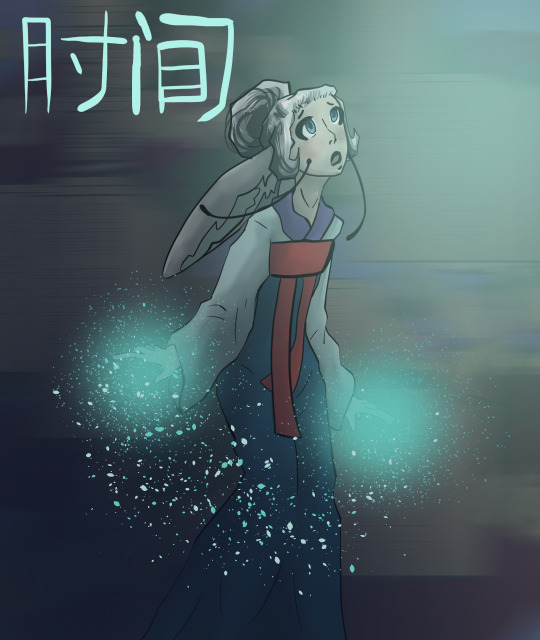


Sorry if it feels like I'm spam posting... ANYWAYS we have three more kwamis for the third and outer ring of the Miracle Box.
Fluff, Longg, and Sass are another three kwamis that belong to the outer/third ring of the Chinese Miracle Box. For more information on this ring, visit my other post here.
First is Fluff: Fluff is the kwami of time and presents female. She wears an outfit inspired by the Sui dynasty. She only grants one power to her wielder, which is the ability to open portals through time. This is the "burrow" which leads to a multitude of realities and times that only Fluff and the wielder of the rabbit miraculous can safely navigate. Fluff has these powers, and she considers herself omnipresent because of her abilities. Fluff is very chaotic in the show so I really enhanced that for her. She's a spaz, constantly all over the place and speaks so fast that often it is hard to understand her. She's constantly talking, either to herself, or blabbing herr mouth off to anyone in earshot. She also has a bad habit of talking over people/not letting people speak. She's very superstitious, so topics like that are her favorite to talk about, even when they're ridiculous. She has... very big eyes so she always appears to be surprised or in awe with everything around her.
Fun fact: When she picks a wielder, they're always from any timeline but the present.
Next we have Longg: Longg is the kwami of perfection and presents androgynously. (They use he/she/they pronouns). His attire comes from the Qing dynasty, and yes, it's a feminine outfit. However, her voice is very masculine. They only grant one power to their wielder, which technically sounds like three when described. The wielder can turn into three types of dragons, air, water, and lightning. The dragon varies from dragon designs across many eastern/asian cultures, but dominantly Chinese inspired. Longg has these powers himself, but much more powerfully and can even switch to dragons of other elements such as fire or ice. Longg kinda has a noble dude vibe in the show and I completely obliterated that. Though she does have a very high esteem of her culture, particularly more ancient practices, she's much less noble and more of a trouble maker. Yes, despite being the kwami of perfection, they're often mischievous or punky. Like Tikki, Longg has very strict rules for picking the wielder of the dragon miraculous, though he tends to be biased about it and would rather pick a trans person over a cisgender person, for no other reason than he just wants someone with the same vibe as him. (She's not cisphobic... if that's a thing).
Fun fact: Longg can switch their body type ever so slightly to range from a more masc appearance to a more fem look whenever they please.
Lastly, my beautiful boy Sass: Sass is the kwami of intuition and presents as male. He wears a hanfu from the Tang dynasty. He only grants one power to his wielder, Second Chance, which is the ability to go back to a "check point" in time within certain limits. This is good for fixing errors that may have occurred during a fight, but also may trap the wielder of the snake miraculous in a time loop if they keep having to use it. Sass has this ability of course, though he rarely ever uses it. I kept his personality similar to what's canon in the show. He's very leaderly and big on maintaining order. He likes to have control over things, and he despises chaos. He has a resting bitch face, which makes him look incredibly irritable all the time. Though he's basically the leader of all the other kwamis, he doesn't speak that much and chooses his words carefully when he does.
Fun fact: He loves music and can play a wide variety of instruments.
#phew#another one#theres so many#there are... six more kwamis to go#oh yeah btw not all the wielders I mention are going to be the canon identities of characters in the show#some of them are the same but others I've changed#I just didn't like the fan service of giving all the miraculous except Longg's and Sass's to Mari's classmates#kinda dumb and predictable tbh#so yeah just try and guess who's gonna actually wield what miraculous#Cause Sass is not linked to Luka anymore so ha#nothing against luka tho we just had to make a change lol#miraculous#mlb#mlbrewrite#chat noir#ladybug#mlbredesign#art catastrophe#art catastrophe mlb rewrite#miracle box#art catastrophe miracle box#kwamis#kwami redesigns#fluff#fluff kwami#longg#sass
24 notes
·
View notes
Text

[Image ID: A pencil sketch of a middle-aged Chinese woman standing at a control booth with levers and switches and holding her other hand up in the air. fantasy script surrounds her raised pointer finger, and she smiles up at the writing. her hair is black, down to her waist and mostly pulled up into a fancy bun situation decorated with a charmed comb and hair stick. she’s wearing a high waisted long sleeved dress and pearls. End ID.]
a quick design sketch of Chien Shiung, one of the secondary characters in Laoche. She’s Madelyn’s mentor in the royal mage academy, and foremost researcher in the magical equivalent of particle physics. I’m watching through 5 hours of thermodynamics crash course youtube videos right now so I thought she was an appropriate drawing topic!
Fun facts! (continued under the cut)
She’s named after the irl Dr. Chien Shiung Wu, one of the researchers on the Manhattan Project, student to a student of Marie Curie, noble prize winner in physics, and all around STEM badass
Her outfit is loosely based on a tang-dynasty Hanfu. loosely based on the silhouette of high waist+long skirt + convex neckline because I thought it looked pretty, but I made the sleeves tighter because that’s a lab hazard. she wears practical lab shoes though. I didn’t put her in a lab coat simply because I wanted to show off the outfit but never fear, she does have one (she just doesn’t need it right now).
Her hair is also loosely based on Tang styles with the high buns and decoration. Mages in Arga traditionally don’t cut their hair because wearing fancy charms in the styles means they always have a source of magic on them and can flaunt their wealth.
I used tang dynasty because it was one of the ones that allowed the most privileges to women and created a bunch of really cool inventions. It was a few centuries off, but “close enough” to other medieval styles and a lot closer in general vibe than 1950s America fashion so I’m hand waving the timeline because this is Laoche, not Earth.
The script is one I came up with in this post! It’s a cobbled together mess of shapes not inspired by a particular writing system, but I wanted it to look at least tangentially similar to Hebrew or Arabic. I’m not building a whole conlang, so it’s just a letter-to-letter substitution of English words for now.
The switchboard she’s working on is only there as a set-piece because of the reference picture I used, but she does work on magical machinery in the book.
Laoche tag list: @thescreamingtwenties @abalonetea @yearlyaquariace @inkwell-attitude @re-writing-h @andiwriteunderthemoon @viawrites-andacts @thescatteredscribbles @booksnotbookies @writeblrfantasy @siarven @talesfromaurea @avian-king @solennitawrites
#qing this for tomorrow because that's when my thermo exam actually is and I probably won't be online lol#the laoche chronicles#laoche#worldbuilding#OC: chien shiung#that's not normally how I tag my characters but I'm doing that so she doesn't get mixed up with the real person#I'm mad she isn't talked about more!#there are so many people who worked on the manhattan project but she's like a BIG DEAL and I'd never heard of her before#I was looking for lady scientist names and I was blown away#her name will be an obscure science history reference but it SHOULDN'T BE#etta rambles
18 notes
·
View notes
Note
would you happen to know anything about chinese armor?
Hi, thanks for the question!
I don’t really know anything about Chinese armor ^^;, but I can offer a few resources to learn more:
- My armor tag has all my content related to Chinese armor, so please check it out if you haven’t already.
- @hanfu-asks and @fouryearsofshades provided some resources on Chinese armor in this post.
- The Baidu Encyclopedia article on armor (Kai Jia/铠甲) has breakdowns on the armor of each time period in Chinese history, along with illustrations. I highly recommend it! It’s in Chinese, but you can use Google Translate if needed :P.
- There’s a really good book called “Illustrated Ancient Chinese Armour/画说中国历代甲胄”, which you can find on Amazon here. There are some scans from the book here. I also found this nifty illustrated timeline of Chinese armor (from the same book):
Qin dynasty (first row) & Han dynasty (second row):

Sui dynasty/Tang dynasty (first row) & Song dynasty (second row):

Yuan dynasty (first row) & Qing dynasty (second row):

Note that the timeline is incomplete (missing Ming dynasty for example). You can view the image as a whole here. If any followers know of additional resources on Chinese armor, please do share!
Hope this helps!
426 notes
·
View notes
Text

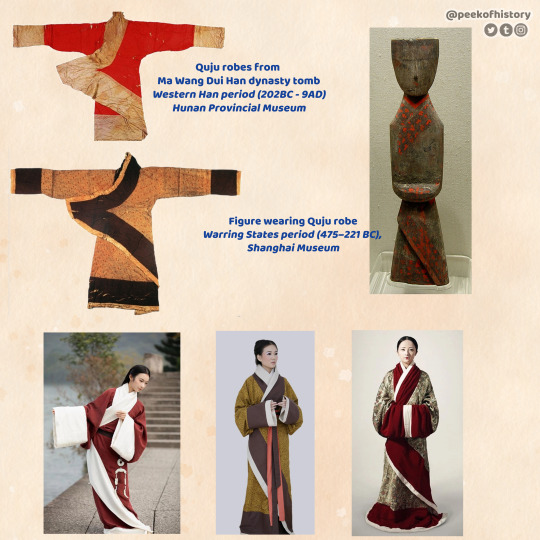

Quju robes are identified by the diagonal cut of the fabric at the front. It was worn around the same time period as the straight-edged Zhiju robes (直裾).
There are actually various types of Quju, some with curved sleeve bottoms, some are straight, some have thin collars, others are thick, etc. but they all share the same diagonal cut, with the fabric being wrapped around the body when worn.
For anyone interested in actually purchasing Hanfu for wear, Quju and Zhiju robes are AMAZING for fall/winter weather. You can wear multiple layers underneath, you can even throw a sweater and jeans underneath and no one would know. In the summer, however, the heavy and excessive fabric makes it feel like you're wearing a portable sauna 🥵🥵
==**==**==**==**==**==**==**==
Hanfu, the historical clothing of the Han people in China, has thousands of years of history. Since the 2000s, there has been a revival of Hanfu within China, with many Hanfu stores opening in the past two decades.
I first became aware that I could purchase Hanfu in 2021 and hoarded a bunch. Recently, I started digging more and more into the topic and realized that, while many of the Hanfu being sold are beautiful, they're not exactly true to the styles of Hanfu in the past. That's not to say they shouldn't be sold or worn, I'm not interested in gatekeeping what others wear, but I became intrigued by what exactly DID the historical Hanfu styles look like based on historical artefacts.
For my own interest, and for any others who might be interested, I'm going to try and do a series of the various Hanfu styles throughout the dynasties.
Chinese dynasties timeline for reference:
Shang Dynasty 商 (1300–1046 BC) Zhou Dynasty 周 (1046–256 BC) Western Zhou 西周 (1046–771 BC) Eastern Zhou 东周 >> Spring and Autumn Period 春秋 (770–481 BC) >> Warring States Period 战国 (481–221 BC) Qin Dynasty 秦 (221–207 BC) Han Dynasty 汉 >> Western Han 西汉 (206 BC–8 AD) >> Xin Dynasty 新 (9–23) >> Eastern Han 东汉 (25–220) Three Kingdoms 三国 (220–265) Jin Dynasty 晋 >> Western Jin 西晋 (265–316) >> Eastern Jin 东晋 (317–420) Northern and Southern Dynasties 南北朝 (420–589) Sui Dynasty 隋 (581–618) Tang Dynasty 唐 (618–907) Five Dynasties 五代 (907–960) Song Dynasty 宋 >> Northern Song 北宋 (960–1127) >> Southern Song 南宋 (1127–1279) Yuan Dynasty (Mongols) 元 (1271–1368) Ming Dynasty 明 (1368–1644) Qing Dynasty (Manchus) 清 (1644–1911) Republic of China 民国 (1912–1949) People's Republic of China 中华人民共和国 (1949-present)
#hanfu#chinese hanfu#china#chinese culture#chinese history#汉服#fashion#historical fashion#clothing#quju#曲裾
232 notes
·
View notes